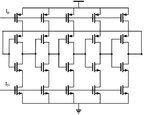mostafah67
Member level 1
i need to know the output capacitance in a output of each stage of a cmos ring oscillator, i know the capacitance is voltage dependent but i need a value for my calculation, i can calculate the capacitance by hand calculations (by using of formulas from digital integrated circuits,by john.M rabaey) but i don't know how they are close to the actual value!
is there a way that i can calculate the capacitance using HSPICE or another software?
is there a way that i can calculate the capacitance using HSPICE or another software?
Last edited:


